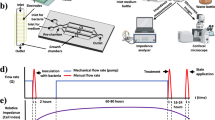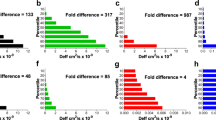Abstract
Bacterial biofilms are a common cause of chronic medical implant infections. Treatment and eradication of biofilms by conventional antibiotic therapy has major drawbacks including toxicity and side effects associated with high-dosage antibiotics. Additionally, administration of high doses of antibiotics may facilitate the emergence of antibiotic resistant bacteria. Thus, there is an urgent need for the development of treatments that are not based on conventional antibiotic therapies. Presented herein is a novel bacterial biofilm combination treatment independent of traditional antibiotics, by using low electric fields in combination with small molecule inhibitors of bacterial quorum sensing – autoinducer-2 analogs. We investigate the effect of this treatment on mature Escherichia coli biofilms by application of an alternating and offset electric potential in combination with the small molecule inhibitor for 24 h using both macro and micro-scale devices. Crystal violet staining of the macro-scale biofilms shows a 46 % decrease in biomass compared to the untreated control. We demonstrate enhanced treatment efficacy of the combination therapy using a high-throughput polydimethylsiloxane-based microfluidic biofilm analysis platform. This microfluidic flow cell is designed to reduce the growth variance of in vitro biofilms while providing an integrated control, and thus allows for a more reliable comparison and evaluation of new biofilm treatments on a single device. We utilize linear array charge-coupled devices to perform real-time tracking of biomass by monitoring changes in optical density. End-point confocal microscopy measurements of biofilms treated with the autoinducer analog and electric fields in the microfluidic device show a 78 % decrease in average biofilm thickness in comparison to the negative controls and demonstrate good correlation with real-time optical density measurements. Additionally, the combination treatment showed 76 % better treatment efficacy compared to conventional antibiotic therapy. Taken together these results suggest that the antibiotic-free combination treatment described here may provide an effective alternative to traditional antibiotic therapies against bacterial biofilm infections. Use of this combination treatment in the medical and environmental fields would alleviate side effects associated with high-dosage antibiotic therapies, and reduce the rise of antibiotic-resistant bacteria.









Similar content being viewed by others
References
S. Al-Nasiry, N. Geusens, M. Hanssens, C. Luyten, R. Pijnenborg, The use of alamar blue assay for quantitative analysis of viability, migration and invasion of choriocarcinoma cells. Hum Reprod (Oxford, England) 22(5), 1304–1309 (2007)
G.G. Anderson and G.A. O’toole. Innate and Induced Resistance Mechanisms of Bacterial Biofilms. Bacterial Biofilms, Springer: 85–105 (2008)
S. A. Blenkinsopp, A. Khoury, J. Costerton, Electrical enhancement of biocide efficacy against pseudomonas aeruginosa biofilms. Appl. Environ. Microbiol. 58(11), 3770–3773 (1992)
R. Caubet, F. Pedarros-Caubet, M. Chu, E. Freye, M. de Belem Rodrigues, J. Moreau, W. Ellison, A radio frequency electric current enhances antibiotic efficacy against bacterial biofilms. Antimicrob. Agents Chemother. 48(12), 4662–4664 (2004)
W. Characklis, Bioengineering report: fouling biofilm development: a process analysis. Biotechnol. Bioeng. 23(9), 1923–1960 (1981)
J. W. Costerton, B. Ellis, K. Lam, F. Johnson, A. E. Khoury, Mechanism of Electrical Enhancement of Efficacy of Antibiotics in Killing Biofilm Bacteria. Antimicrob Agents Chemother 38(12), 2803–2809 (1994)
J. W. Costerton, P. S. Stewart, E. P. Greenberg, Bacterial biofilms: A common cause of persistent infections. Science 284(5418), 1318–1322 (1999)
M. P. DeLisa, J. J. Valdes, W. E. Bentley, Mapping stress-induced changes in autoinducer Ai-2 production in Chemostat-cultivated Escherichia coli K-12. J. Bacteriol. 183(9), 2918–2928 (2001)
C. A. Fux, P. Stoodley, L. Hall-Stoodley, J. W. Costerton, Bacterial biofilms: A diagnostic and therapeutic challenge. Expert Rev Anti-Infect Ther 1(4), 667–683 (2003)
S. Gamby, V. Roy, M. Guo, J. A. Smith, J. Wang, J. E. Stewart, X. Wang, W. E. Bentley, H. O. Sintim, Altering the communication networks of multispecies microbial systems using a diverse toolbox of Ai-2 analogues. ACS Chem. Biol. 7(6), 1023–1030 (2012)
M. Ghannoum and G.A. O’Toole. Microbial Biofilms, ASM Press (2004)
M. Giladi, Y. Porat, A. Blatt, E. Shmueli, Y. Wasserman, E. D. Kirson, Y. Palti, Microbial growth inhibition by alternating electric fields in mice with pseudomonas aeruginosa lung infection. Antimicrob. Agents Chemother. 54(8), 3212–3218 (2010)
A. Heydorn, A. T. Nielsen, M. Hentzer, C. Sternberg, M. Givskov, B. K. Ersbøll, S. Molin, Quantification of biofilm structures by the novel computer program Comstat. Microbiology 146(10), 2395–2407 (2000)
A. Huq, C. A. Whitehouse, C. J. Grim, M. Alam, R. R. Colwell, Biofilms in water, its role and impact in human disease transmission." current opinion in. Biotechnology 19(3), 244–247 (2008)
W. Jun, M. S. Kim, B.-K. Cho, P. D. Millner, K. Chao, D. E. Chan, Microbial biofilm detection on food contact surfaces by macro-scale fluorescence imaging. J. Food Eng. 99(3), 314–322 (2010)
Y.W. Kim, M.P. Mosteller, M.T. Meyer, H. Ben-Yoav, W.E. Bentley and R. Ghodssi. Microfluidic biofilm observation, analysis, and treatment (Micro-Boat) Platform. Hilton Head Workshop 2012: A solid-state sensors, actuators and microsystems workshop, Hilton Head, SC (2012)
Y. W. Kim, S. Subramanian, K. Gerasopoulos, H. Ben-Yoav, H.-C. Wu, D. Quan, K. Carter, M. T. Meyer, W. E. Bentley, R. Ghodssi, Effect of electrical energy on the efficacy of biofilm treatment using the bioelectric effect. Npj Biofilms Microbiomes 1, 15016 (2015)
Y. W. Kim, M. P. Mosteller, S. Subramanian, M. T. Meyer, W. E. Bentley, R. Ghodssi, An optical microfluidic platform for spatiotemporal biofilm treatment monitoring. J Micromech Microeng 26(1), 015013 (2016)
J.H. Merritt, D.E. Kadouri and G.A. O’Toole. Growing and analyzing static biofilms. Current protocols in microbiology, John Wiley & Sons, Inc. (2005)
M. T. Meyer, V. Roy, W. E. Bentley, R. Ghodssi, Development and validation of a microfluidic reactor for biofilm monitoring via optical methods. J Micromech Microeng 21(5), 054023 (2011)
M. T. Meyer, S. Subramanian, Y. W. Kim, H. Ben-Yoav, M. Gnerlich, W. E. Bentley, R. Ghodssi, Multi-depth Valved microfluidics for biofilm segmentation. J. icromech. Microeng. 25, 095003 (2015)
M. B. Miller, B. L. Bassler, Quorum sensing in bacteria." annual reviews in. Microbiology 55(1), 165–199 (2001)
G.A. O’Toole, L.A. Pratt, P.I. Watnick, D.K. Newman, V.B. Weaver and R. Kolter. Genetic approaches to study of biofilms. Methods in Enzymology. J.R. Doyle, Academic Press. 310: 91–109 (1999).
A. Pareilleux, N. Sicard, Lethal effects of electric current on Escherichia coli. Appl Microbiol 19(3), 421–424 (1970)
J. Pozo, R. Patel, The challenge of treating biofilm-associated bacterial infections. Clin Pharmacol Ther 82(2), 204–209 (2007)
D. N. Quan, W. E. Bentley, Gene network homology in prokaryotes using a similarity search approach: queries of quorum sensing signal transduction. PLoS Comput Biol 8(8), e1002637 (2012)
T. B. Rasmussen, M. Givskov, Quorum sensing inhibitors: a bargain of effects. Microbiology 152(4), 895–904 (2006a)
T. B. Rasmussen, M. Givskov, Quorum-sensing inhibitors as anti-pathogenic drugs. International Journal of Medical Microbiology 296(2–3), 149–161 (2006b)
B. W. Roberts, W. L. Olbricht, The distribution of freely suspended particles at microfluidic bifurcations. AICHE J. 52(1), 199–206 (2006)
V. Roy, R. Fernandes, C.-Y. Tsao, W. E. Bentley, Cross species quorum quenching using a native Ai-2 processing enzyme. ACS Chem. Biol. 5(2), 223–232 (2009)
V. Roy, J. A. Smith, J. Wang, J. E. Stewart, W. E. Bentley, H. O. Sintim, Synthetic analogs tailor native Ai-2 signaling across bacterial species. J. Am. Chem. Soc. 132(32), 11141–11150 (2010)
V. Roy, B. L. Adams, W. E. Bentley, Developing next generation antimicrobials by intercepting ai-2 mediated quorum sensing. Enzym Microb Technol 49(2), 113–123 (2011)
V. Roy, M. T. Meyer, J. A. I. Smith, S. Gamby, H. O. Sintim, R. Ghodssi, W. E. Bentley, Ai-2 analogs and antibiotics: a synergistic approach to reduce bacterial biofilms. Appl. Microbiol. Biotechnol. 97(6), 2627–2638 (2013)
P. S. Stewart, W. Wattanakaroon, L. Goodrum, S. M. Fortun, B. R. McLeod, Electrolytic generation of oxygen partially explains electrical enhancement of tobramycin efficacy against pseudomonas aeruginosa biofilm. Antimicrob. Agents Chemother. 43(2), 292–296 (1999)
P. Stoodley, D. DeBeer, H. M. Lappin-Scott, Influence of electric fields and Ph on biofilm structure as related to the bioelectric effect. Antimicrob. Agents Chemother. 41(9), 1876–1879 (1997)
P. Stoodley, K. Sauer, D. Davies, J. W. Costerton, Biofilms as complex differentiated communities. annual reviews in. Microbiology 56(1), 187–209 (2002)
S. Subramanian, Y.W. Kim, M.T. Meyer, H.O. Sintim, W.E. Bentley and R. Ghodssi. A real-time bacterial biofilm characterization platform using a microfluidic system. Hilton Head Workshop 2014: A solid-state sensors, actuators and microsystems workshop, Hilton Head, SC (2014)
S. Subramanian, K. Gerasopoulos, H.O. Sintim, W.E. Bentley and R. Ghodssi. A bacterial biofilm combination treatment using a real-time microfluidic platform. The 18th international conference on solid-state sensors, actuators and microsystems (Transducers), Anchorage, AK (2015)
K. Toté, D. V. Berghe, L. Maes, P. Cos, A new colorimetric microtitre model for the detection of Staphylococcus aureus biofilms. Lett. Appl. Microbiol. 46(2), 249–254 (2008)
L. Wang, J. Li, J. C. March, J. J. Valdes, W. E. Bentley, Luxs-dependent Gene regulation in Escherichia coli K-12 revealed by genomic expression profiling. J. Bacteriol. 187(24), 8350–8360 (2005)
C. M. Waters, B. L. Bassler, Quorum sensing: cell-to-cell communication in bacteria. Annu. Rev. Cell Dev. Biol. 21, 319–346 (2005)
N. Wellman, S. M. Fortun, B. R. McLeod, Bacterial biofilms and the bioelectric effect. Antimicrob. Agents Chemother. 40(9), 2012–2014 (1996)
Acknowledgments
The authors would like to acknowledge the Robert W. Deutsch Foundation, the Centers of Excellence in Regulatory Science and Innovation (CERSI) at the Food and Drug Administration (FDA) and NSF (CBET 1264509) for their financial support. The authors would also like to thank the Maryland Nanocenter and its FabLab staff. Finally, the authors thank Drs. Young Wook Kim and Mariana Meyer for their useful consulting on biofilm growth experiments.
Author information
Authors and Affiliations
Corresponding authors
Electronic supplementary material
ESM 1
(DOCX 1651 kb)
Rights and permissions
About this article
Cite this article
Subramanian, S., Gerasopoulos, K., Guo, M. et al. Autoinducer-2 analogs and electric fields - an antibiotic-free bacterial biofilm combination treatment. Biomed Microdevices 18, 95 (2016). https://doi.org/10.1007/s10544-016-0120-9
Published:
DOI: https://doi.org/10.1007/s10544-016-0120-9




